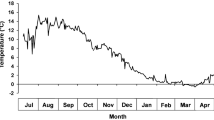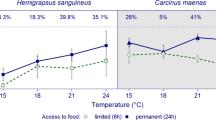Abstract
The responses of the different stages of an organism’s life-cycle to different environments can have important implications for their persistence in those habitats. The marine intertidal zone is considered among the most stressful of all marine environments, because daily exposure at low tide results in daily fluctuations in a range of important environmental factors. In this study we examined the link between daytime exposure and the performance of embryos, juveniles and adults of the seaweed Fucus gardneri across zones and seasons on San Juan Island, Washington, USA. Specifically we asked: (1) whether three measures of performance for F. gardneri: growth rates, surface area of reproductive tissue and survivorship differed between high- and mid-intertidal zones, and among months throughout the year and, then, (2) whether total daytime exposure within each zone each month was a good predictor of variation in these measures of performance. At our study site, seasonal differences in the timing of low tides result in long periods each day during summer of very harsh conditions (exposure to the air, high temperatures and low humidity) compared to winter when exposure to the air during the day is virtually absent. Contrary to the expectation of lower performance in the high zone, we found no consistent differences between zones over the entire year in any measure of performance for any stage. For nearly all traits, there were significant differences among months and, importantly, significant interactions between zone and month. Thus, for each stage there were some months when thalli in the high zone performed better and some months when thalli in the mid-zone performed better. Regressions between total daytime exposure and performance each month indicated some stage-specific effects. Larger thalli appeared more strongly affected by the amount of exposure per month; there were significant negative relationships between total daytime exposure and (1) growth rates of medium and large adults in the high zone and (2) the surface area of reproductive tissue of medium adults in the high zone and small adults in the mid-zone. The lowest survivorship for all stages occurred in the 2–3 months that followed summer, suggesting a cumulative effect of long daytime exposure in summer on survivorship. Post-settlement survivorship of embryos was very low throughout the year, with only 2 out of 5395 seeded zygotes surviving to a visible size. One-month post-settlement survivorship ranged from 0% to 16.7%, and there were no differences in the survivorship curves between high- and mid-intertidal zones for each cohort. Although it is often assumed that the performance of intertidal species is lower in high-intertidal zones because of exposure to environmental extremes for longer, our results do not support this paradigm. Instead, they indicate a complex and fluctuating pattern of variation in the performance of different stages of the F. gardneri life-cycle throughout the year in different intertidal zones.





Similar content being viewed by others
References
Abbott IA, Hollenberg GJ (1976) Marine algae of California. Stanford University Press, Stanford, Calif., USA
Åberg P (1992a) A demographic study of two populations of the seaweed Ascophyllum nodosum. Ecology 73:1473–1487
Åberg P (1992b) Size-based demography of the seaweed Ascophyllum nodosum in stochastic environments. Ecology 73:1488–1501
Ang PO (1991a) Natural dynamics of a Fucus distichus (Phaeophyceae, Fucales) population: reproduction and recruitment. Mar Ecol Prog Ser 78:71–85
Ang PO (1991b) Age- and size-dependent growth and mortality in a population of Fucus distichus. Mar Ecol Prog Ser 78:173–187
Ang PO, De Wreede RE (1992) Density-dependence in a population of Fucus distichus. Mar Ecol Prog Ser 90:169–181
Baker SM (1909) On the causes of the zoning of brown seaweeds on the seashore. New Phytol 8:196–202
Baker SM (1910) On the causes of the zoning of brown seaweeds on the seashore. II. The effect of periodic exposure on the expulsion of gametes and on the germination of the oospore. New Phytol 9:54–67
Bell EC (1993) Photosynthetic response to temperature and desiccation of the intertidal alga Mastocarpus papillatus. Mar Biol 117:337–346
Berger R, Malm T, Kautsky L (2001) Two reproductive strategies in Baltic Fucus vesiculosus (Phaeophyceae). Eur J Phycol 36:265–273
Berndt M-L, Callow JA, Brawley SH (2002) Gamete concentrations and timing and success of fertilization in a rocky shore seaweed. Mar Ecol Prog Ser 226:273–285
Bertness MD, Leonard GH, Levine JM, Schmidt PR, Ingraham AO (1999) Testing the relative contribution of positive and negative interactions in rocky intertidal communities. Ecology 80:2711–2726
Blanchette CA (1997) Size and survival of intertidal plants in response to wave action: a case study with Fucus gardneri. Ecology 78:1563–1578
Brawley SH (1992) Fertilisation in natural populations of the dioecious brown alga Fucus ceranoides and the importance of the polyspermy block. Mar Biol 113:145–157
Brawley SH, Johnson LE (1991) Survival of fucoid embryos in the intertidal zone depends upon developmental stage and microhabitat. J Phycol 29:179–186
Brawley SH, Johnson LE (1993) Predicting desiccation stress in microscopic organisms: the use of agarose beads to determine evaporation within and between intertidal microhabitats. J Phycol 29:528–535
Brawley SH, Johnson LE, Pearson GA, Speransky V, Li R, Serrăo EA (1999) Gamete release at low tide in fucoid algae: maladaptive or advantageous? Am Zool 39:218–229
Caswell H (2001) Matrix population models, 2nd edn. Sinaur, Sunderland, Mass., USA
Cervin G, Åberg P (1997) Do littorinids affect the survival of Ascophyllum nodosum germlings? J Exp Mar Biol Ecol 218:35–47
Chapman ARO (1995) Functional ecology of fucoid algae: twenty-three years of progress. Phycologia 34:1–32
Chapman ARO, Fletcher RL (2002) Differential effects of sediments on survival and growth of Fucus serratus embryos (Fucales, Phaeophyceae). J Phycol 38:894–903
Davison MW, Pearson GA (1996) Stress tolerance in intertidal seaweeds. J Phycol 32:197–211
Edwards MS (2000) The role of alternate life-history stages of a marine macroalga: a seed bank analogue? Ecology 81:2404–2415
Haring RN, Dethier MN, Williams SL (2002) Desiccation facilitates wave-induced mortality of the intertidal alga Fucus gardneri. Mar Ecol Prog Ser 232:75–82
Hawkins SJ, Hartnoll RG (1985) Factors determining the upper limits of intertidal canopy-forming algae. Mar Ecol Prog Ser 20:265–271
Helmuth BST (2002) How do we measure the environment? Linking intertidal thermal physiology and ecology through biophysics. Integr Comp Biol 42:837–845
Helmuth BST, Hofmann GE (2001) Microhabitats, thermal heterogeneity, and patterns of physiological stress in the rocky intertidal zone. Biol Bull (Woods Hole) 201:374–384
Helmuth BST, Harley CDG, Halpin PM, O’Donnell M, Hofmann GE, Blanchette CA (2002) Climate change and latitudinal patterns of intertidal thermal stress. Science 298:1015–1017
Horvitz CC, Schemske DW (1995) Spatiotemporal variation in demographic transitions of a tropical understory herb—projection matrix analysis. Ecol Monogr 65:155–192
Hutchings MJ, Booth KD, Waite S (1991) Comparison of survivorship by the log rank test: criticisms and alternatives. Ecology 72:2290–2293
Johnson LE, Brawley SH (1998) Dispersal and recruitment of a canopy-forming intertidal alga: the relative roles of propagule availability and post-settlement survivorship. Oecologia 117:517–526
Kinlan BP, Graham MH, Sala E, Dayton PK (2003) Arrested development of giant kelp (Macrocystis pyrifera, Phaeophyceae) embryonic sporophytes: a mechanism for delayed recruitment in perennial kelps? J Phycol 39:47–57
Li R, Brawley SH (2003) Improved survival under heat stress in intertidal embryos (Fucus spp.) simultaneously exposed to hypersalinity and the effect of parental thermal history. Mar Biol 144:205–213
Mandujano MC, Montana C, Franco M, Golubov J, Flores-Matrinez A (2001) integration of demographic annual variability in a clonal desert cactus. Ecology 82:344–359
Menge BA, Branch GM (2001) Rocky intertidal communities. In: Bertness MD, Gaines SD, Hay ME (eds) Marine community ecology. Sinauer, Sunderland, Mass., USA, pp 221–251
Paine RT, Levin SA (1981) Intertidal landscapes: disturbances and the dynamics of pattern. Ecol Monogr 51:145–178
Pearson GA, Brawley SH (1996) Reproductive ecology of Fucus distichus (Phaeophyceae): an intertidal alga with successful external fertilisation. Mar Ecol Prog Ser 143:211–223
Pearson GA, Davison IR (1993) Freezing rate and duration determine the physiological response of intertidal fucoids to freezing. Mar Biol 115:353–362
Ramage DL, Schiel DR (1998) Reproduction in the seagrass Zostera novazelandica on intertidal platforms in southern New Zealand. Mar Biol 130:479–489
Schonbeck MW, Norton TA (1978) Factors controlling the upper limits of fucoid algae on the shore. J Exp Mar Biol Ecol 31:303–313
Schonbeck MW, Norton TA (1980) The effects on intertidal fucoid algae of exposure to air under various conditions. Bot Mar 23:141–147
Serrăo EA, Pearson G, Kautsky L, Brawley SH (1996) Successful fertilisation in turbulent environments. Proc Natl Acad Sci USA 93:5286–5290
Sideman EJ, Mathieson AC (1983) Ecological and genecological distinctions of a high intertidal dwarf form of Fucus distichus (L.) Powell in New England. J Exp Mar Biol Ecol 72:171–188
Stengel DB, Dring MJ (1997) Morphology and in situ growth rates of plants of Ascophyllum nodosum (Phaeophyta) from different shore levels and responses of plants to vertical transplantation. Eur J Phycol 32:193–202
Thom RM (1983) Spatial and temporal patterns of Fucus distichus ssp. edentatus (de la Pyl.) Pow. (Phaeophyceae: Fucales) in central Puget Sound. Bot Mar 26:471–486
Tomanek L, Helmuth BST (2002) Physiological ecology of rocky intertidal organisms: a synergy of concepts. Integr Comp Biol 42:771–775
Tomanek L, Somero GN (1999) Evolutionary and acclimation-induced variation in the heat-shock responses of congeneric marine snails (genus Tegula) from different habitats: implications for limits of thermotolerance and biogeography. J Exp Biol 202:2925–2936
Vadas RL, Wright WA, Miller SL (1990) Recruitment of Ascophyllum nodosum: wave action as a source of mortality. Mar Ecol Prog Ser 61:263–272
Vadas RL, Johnson S, Norton TA (1992) Recruitment and mortality of early post-settlement stages of benthic algae. Br Phycol J 27:331–351
Van Tamelen PG, Stekoll MS, Deysher L (1997) Recovery processes of the brown alga Fucus gardneri following the ‘Exxon Valdez’ oil spill: settlement and recruitment. Mar Ecol Prog Ser 160:265–277
Viejo RM, Åberg P, Cervin G, Lindegarth M (1999) The interactive effects of adult canopy, germling density and grazing on germling survival of the rockweed Ascophyllum nodosum. Mar Ecol Prog Ser 187:113–120
Wright JT, Steinberg PD (2001) Effects of variable recruitment and post-recruitment herbivory on local population size of a marine alga. Ecology 82:2200–2215
Acknowledgements
We thank S. Brady, A. Carew, C. Catton, M. Chalfoun and, particularly, A. Freeman for field assistance. Dr. L. Johnson provided a helpful discussion of techniques to examine post-settlement survivorship. This project was supported by NSF grant no. OCE-98186078 and no. 0196078 to S.L.W. and no. 9901138 to M.N.D. This is contribution number 2200, Bodega Marine Laboratory, University of California at Davis.
Author information
Authors and Affiliations
Corresponding author
Additional information
Communicated by M.S. Johnson, Crawley
Rights and permissions
About this article
Cite this article
Wright, J.T., Williams, S.L. & Dethier, M.N. No zone is always greener: variation in the performance of Fucus gardneri embryos, juveniles and adults across tidal zone and season. Marine Biology 145, 1061–1073 (2004). https://doi.org/10.1007/s00227-004-1399-2
Received:
Accepted:
Published:
Issue Date:
DOI: https://doi.org/10.1007/s00227-004-1399-2




